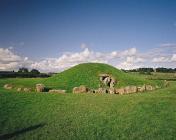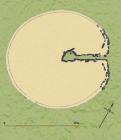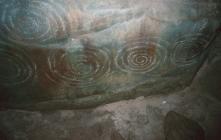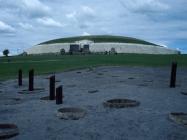The burial tombs of Stone Age Wales
Items in this story:
Common Culture
5,500 years ago a common culture spread around the Atlantic coast of Europe linking Brittany, Cornwall, Wales, southern Scotland and Ireland.
Today, evidence of this culture survives in the form of passage tombs - circular burial mounds pierced by stone-lined passages that open into central chambers.
Stone Age Crematoriums
These tombs were built by early farming communities to house the cremated remains of their dead and were used for generations. They must have been important landmarks that linked the living with their ancestors.
Within Wales, passage tombs are best seen on Anglesey where two important examples are sufficiently well-preserved to allow public access - Barclodiad y Gawres and Bryn Celli Ddu.
Barclodiad y Gawres ('the apronful of the giantess') was built with a main chamber flanked by three side-chambers in which the dead would have been placed. In the centre of the main chamber was a hearth from which a fire would have illuminated the tomb during rituals.
Witches brew and spiral artwork
To the surprise of the archaeologists excavating the site, the hearth contained a strange mix of reptile, fish and amphibian bones. While the reason for this 'witches brew' will never be known, one important insight into the culture of these tomb builders is the strange artwork that is pecked into the rocks that line the passage and chamber. These designs include spirals and strange meandering zig-zag patterns.
On their own they might be dismissed as a whim of the builders, but this type of design is also found within other passage tombs as far afield as Ireland and Brittany.
A similarly patterned stone was found at Bryn Celli Ddu (Anglesey). However, here the stone was discovered lying face down in a pit beneath the tomb's chamber where it must have been buried before tomb building began. Was it buried in order to sanctify the site, or was it buried to hide it away? - another unanswered mystery.
The passage tombs on Anglesey are not the only ones in Wales. Other examples are known from Gwynedd and Pembrokeshire, although these are less well-preserved.
Grand ambitions
The largest and most complex passage tombs occur in Ireland. The tombs at Newgrange and Knowth show how grand the ambitions of the tomb builders could be.
At Knowth the central tomb is accompanied by a cemetery of at least 18 smaller examples, while at Newgrange skilled engineers precisely aligned the passage way with the mid-winter sunrise.
In all of the areas where passage tombs appear they are built to slightly different designs, but there is sufficient similarity between them all to indicate that the Irish Sea was a thriving highway at the end of the Stone Age, with communities from Brittany to Scotland sharing both ideas and ways of respecting the dead.
Background Reading
The Tomb Builders: In Wales 4000-3000BC by Steve Burrow. National Museum Wales Books (2006)
Barclodiad y Gawres: the excavation of a megalithic chamber tomb in Anglesey, 1952-1953 by T. G. E. Powell and G. E. Daniel. Liverpool University Press (1956).
Irish Passage Graves: Neolithic tomb builders in Ireland and Britain 2500BC by M. Herity. Dublin University Press (1974).
'The chambered cairn of Bryn Celli Ddu' by W. J. Hemp. In Archaeologia Cambrensis vol. 86, p216-58 (1931).




